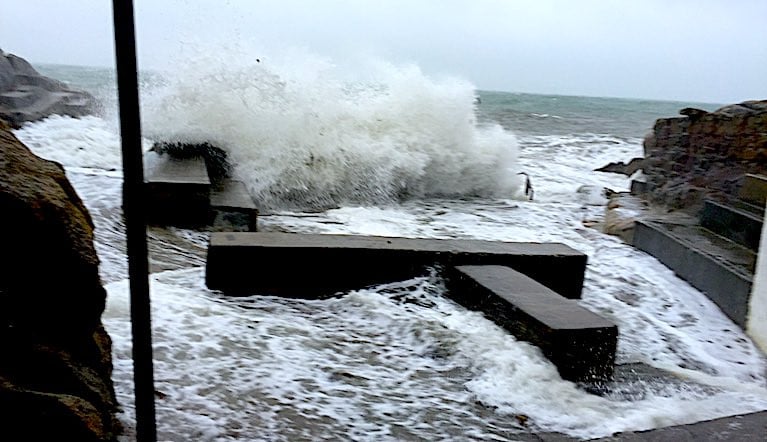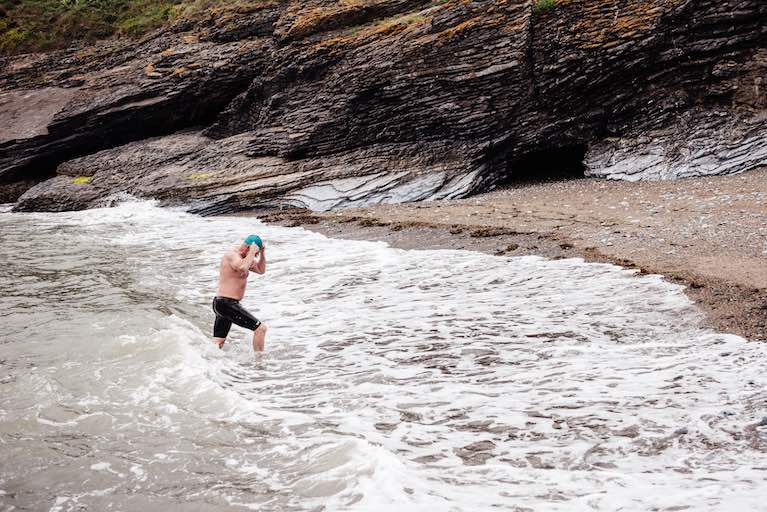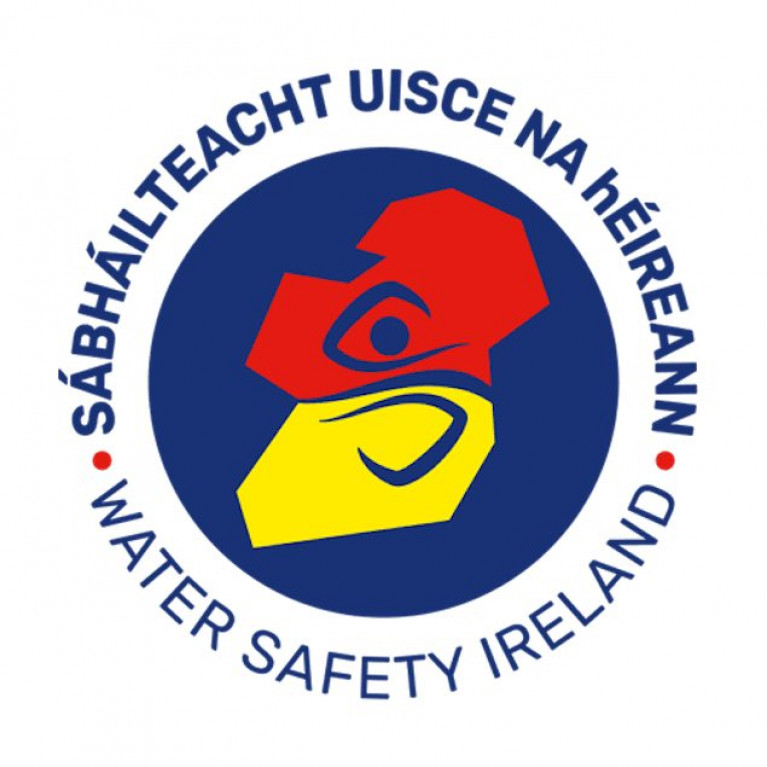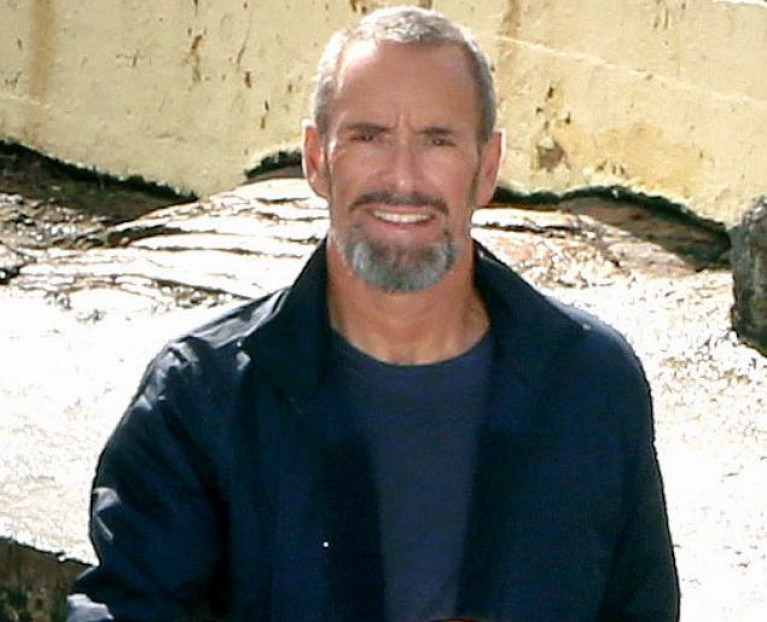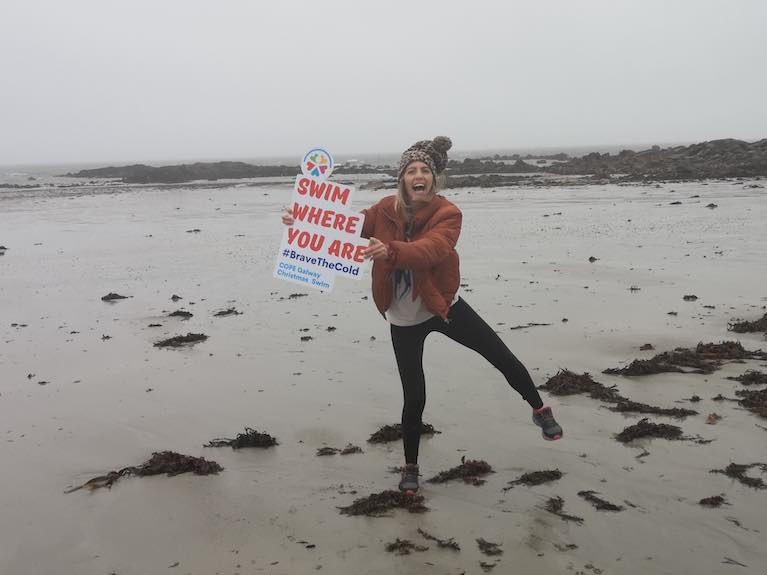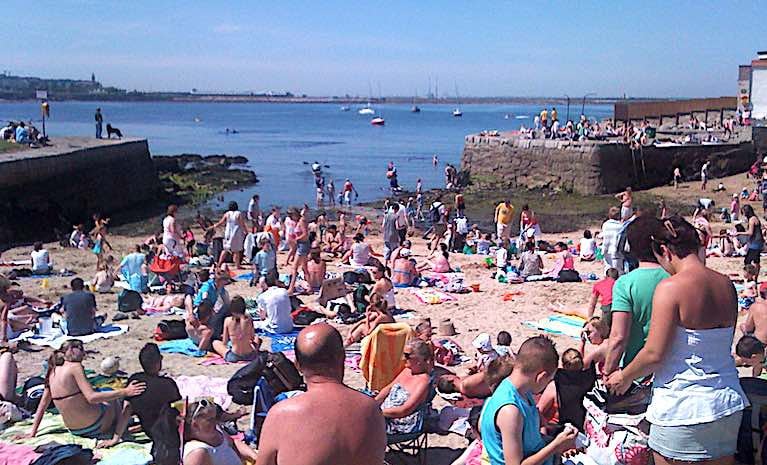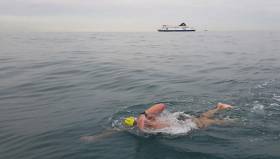Displaying items by tag: Sea Swimming
Renowned swimmer Henry O’Donnell is set to bring his 1500km, round Ireland Finswim to a close. In doing so he will become the first person to circumnavigate the island of Ireland by swimming with the use of fins.
The expedition is expected to conclude at Henry’s native Carrickfinn in County Donegal, where he first set off on his journey around Ireland on September 17th 2020.
O’Donnell has undertaken the challenge to raise much-needed funds for national charities Water Safety Ireland and the Irish Cancer Society, and to date has raised over €46,000. Henry has been a keen advocate for both charities, as he delivered safety talks to children and the public throughout his swim.
Listen into O’Donnell talking to Lorna Siggins about his round Ireland Finswim on podcast here
Galway's Blackrock "Men Only" Bathing Ban Recalled in Culture Night Documentary
It is 50 years ago since a “Men Only” sign was removed from the entrance to Galway’s Blackrock swimming area.
Before this, bathing was officially segregated in Salthill on Galway Bay, at the request of Catholic bishops who believed mixed bathing could be occasions of sin.
From the 1930s, when swimming became popular, women were directed to Ladies beach, while families were accommodated close by.
By the end of the 1960s, however, attitudes had changed and rules were not so rigidly observed.
A 15-minute documentary by Mary Cunningham which is available online for this year’s Culture Night interviews people who swam at Salthill in the 1960s, and remember the influence of the Catholic church on social behaviour.
Jane Hogan and Maude O’Donohoe recall one young woman's rebellion against the rules sometime in the mid 1960s, when she swam up to the male section at Blackrock and left her bikini top on a flagpole.
Year round swimmer P.J. Flaherty recalls the camaraderie that existed among the men who frequented the area, and the resentment of some at the arrival of women.
In 1971, a local councillor requested that Galway Corporation ban so-called “Bikini Girls”' from the “male enclave”, as they disturbed the older men and priests who swam there.
However, by then attitudes had changed and the “Men Only” sign was quietly removed in early September, 50 years ago.
Listen to The Bracing Waters and Moral Dangers of Salthill HERE
One of Ireland’s longest one-day sea swimming events will extend over a month this year, as the annual Frances Thornton Memorial Galway Bay Swim goes “virtual” again.
The event in aid of Cancer Care West, which is now in its 16th year, raised a record-breaking 185,000 euro in 2020 when it was re-imagined to meet Covid-19 restrictions.
It would normally see 150 people crossing the bay one day in July, swimming 13km solo or in relay teams from Aughinish, Co Clare to Salthill’s Blackrock diving tower.
Since the swim began 15 years ago, a total of 740 people have transited the bay.
As with last year’s format, participants are encouraged to swim a total of 13km during the month of August – which can be broken up, and can take place anywhere in the world.
“The swim is much more than a fundraiser; it's the swimming highlight for so many across Ireland,” Cancer Care West director Brian Thornton has explained.
“Last year, the swimming community in Ireland and swimmers around the world as far as Australia took to the water and made the 2020 Galway Bay Swim one we truly will never forget, for all the right reasons,” he says.
“ We would naturally love to be swimming the bay in one day but until we can do this safely, this month-long event allows everyone to be part of something so positive,” he says.
"The monies raised will help fund support services for cancer patients and their families through our support centres ” he adds.
All year round swimmer Paddy McNamara says the event gives an opportunity to swimmers of all abilities to do something special for Cancer Care West.
“This challenge can be completed anywhere in the world so it would be great to see a local and international element to the event," he says.
Participants are asked to raise €100 for Cancer Care West and those who complete the challenge qualify for a Galway Bay Swim t-shirt and a branded swim cap.
Registration is open now here
Forty Foot Sea Swimmers Rescued by Coastguard on Stormy Dublin Bay
The Irish Coast Guard rescued two swimmers after they ran into difficulty while swimming at the Forty Foot bathing place on Dublin Bay yesterday.
The incident occurred earlier today as the swimmers required help in the choppy sea. The Dun Laoghaire Harbour branch of the Coast Guard confirmed that one of the swimmers also required medical assistance.
Thankfully, all persons are understood to be ok.
Personnel from the National Ambulance Service, Dublin Fire Brigade, RNLI Dun Laoghaire Lifeboat Station, and An Garda Síochána were required during the rescue operation.
In a statement, the Coast Guard said: "We have had two callouts this morning involving swimmers. Conditions are unsafe along our coastline and continue to be unsafe for the rest of the week due to strong easterly winds.
Sea swimming weather and wave safety is the theme of an online talk tonight - the first in a new series hosted by Swim Ireland and the RNLI.
In response to the surge in interest in open water swimming during the pandemic, the series of talks will deal with all aspects of safety and planning to ensure swimmers can make informed decisions and within Covid-19 guidelines.
RNLI Water Safety lead Kevin Rahill will host this evening’s webinar at 7 pm.
Booking is €5 and all proceeds go to support the RNLI’s volunteer lifeboat crews.
Topics covered include
- Where to get your forecast
- What the terms mean
- Using the forecast to make your decision
- How weather affects waves
- Other factors affecting waves
- Types of waves and how they can affect you
- Weather, waves and your visibility
“With more people getting involved in open water swimming, we are delighted to work in partnership with Swim Ireland to help those taking part, whether new or experienced swimmers, to continue to enjoy the sport safely,” Mr Rahill says.
 More people are getting involved in open water swimming
More people are getting involved in open water swimming
“ We are happy to share our knowledge and experience through these webinars to help everyone make informed decisions about where and when to swim and what steps one can take to ensure a fun and safe experience,” he said.
Grainne Murphy, Get Ireland Swimming national co-ordinator said described as “ unprecedented” the increase in people dipping into open waters across the island of Ireland.
“ In the summer we were able to support more than 700 swimmers by providing coached sessions and lessons as part of our Open Water Programmes,” she said.
“ It is even more important to support newcomers in the cold winter, which is why we have partnered with the RNLI to provide an ongoing series of educational webinars, that deliver key safety messages, and provide a platform for all to speak directly to experts in open water swimming and in open water safety,” she said.
“ These sessions aim to build participants’ confidence and a strong awareness of the importance of taking safety precautions when in or around open water.”
Running alongside the joint RNLI and Swim Ireland Open Water webinars will be a series of 30-minute ‘Lunch Break Chats’, providing education on ice swimming, swim route planning, and Channel swimming.
Swim Ireland’s Instagram channel is planning “live chats”, including with Irish ex-international marathon swimmer Chris Bryan, who will have a focus on improving swimmers’ knowledge of open water.
Sea Swim Webinars
- Monday, January 25th - Weather and Waves with RNLI, 7 pm l €5 l Book HERE.
- Thursday, January 28th - talk with Irish Ice Swimming Association chair Tiffany Quinn – a 30-minute question and answer session on ice swimming. Visit the event booking page to secure your place.
- Monday, February 8th - Dee’s Experience with Antarctic swimmer Dee Newell, 7 pm €5 Book HERE
- Monday, February 22nd - Tides and Currents with RNLI, 7 pm €5 Book HERE.
- Monday, March 8th - Route Planning for Open Water Swimmers, 7 pm €5 Book HERE.

Christmas Swims Must Be Different This Year - Water Safety
This Christmas is very different from all our other Christmases we have experienced and thousands of people around the country who will want to immerse themselves in our invigorating waters must demonstrate compliance with our NPHET guidelines says John Leech of Water Safety Ireland.
We advise Charity Fundraising Organisers to ensure that only small groups of swimmers descend upon our favourite swimming locations at any one time and that their events be spread out over the holiday period to ensure we do not have any breaches of the NPHET Guidelines. We simply cannot have large groupings of well-meaning charity supporters converging at our favourite bathing places. Swim at known safe bathing places where there is public rescue equipment available should a swimmer get in to difficulty.
Our country has seen an explosion in the number of people involved in open water swimming since the arrival of COVID-19 and on the whole people have been compliant in terms of adhering to social distancing, wearing masks and hand hygiene. Christmas swims have grown in popularity in recent years as it is a very sociable experience as well as raising much-needed funds for charities.
Charity swimmers occasionally take chances beyond what is acceptably safe, finding themselves left without sufficient strength to climb out of the water due to the cold. Cold winter waters cause “cold shock” and hypothermia can set in within a short period, especially if there is a high wind chill factor, this can overwhelm the fittest of swimmers. Immediately before the swim, people should throw cold water on themselves and always ease into the water slowly introducing your body to the low temperature. If you see a person in difficulty, do not attempt a rescue for which you are not trained. Make use of nearby public rescue equipment such as a ringbuoy.
Charity Swim guidelines:
- People organising these swims on Christmas Day, St. Stephen’s Day or New Year’s Day must ensure full compliance with NPHET Guidelines and that they provide comprehensive details of each event to the Irish Coast Guard and local Gardaí in advance of their event.
- Each event should have a Safety Officer appointed, who will advise those concerned on safety and have the ultimate responsibility for making decisions in relation to the swim being on or off on the day.
- If the seas are rough and weather deteriorates, they should defer the event to a more suitable day without question – if in doubt do not take a chance on running the event.
Many participants will not have swum since the summer and the temperature of the water has now dropped considerably. It is a fallacy that alcohol will keep you warm when entering the water; in fact, it has the reverse effect and could kill you. No alcohol should be taken before or after the swim. - Please use our Open Water Safety Leaflet to prepare for your swim here
- Cold water can cause cold shock and hypothermia in minutes because the temperature of the water at this time of year may be below 6° Celsius in Fresh Water and 10° Celsius in Seawater.
- Ensure that you have safe access and egress with appropriate shallow shelving beaches, steps, slipway or ladders as appropriate. People should be mindful that steps leading into the water might be dangerous due to the increased growth of algae in wintertime. Organisers must ensure that they have had the access and egress cleaned in advance of the swim to avoid slips and falls.
- Fancy dress outfits can seriously impair your ability to float – please do not wear when swimming.
- Swimmers’ remaining in the water for extended periods in a gesture of bravado is not acceptable and leads to hypothermia. Our message is “Get In, Get Out and Warm Up”.
Another Rescue in Galway Bay Prompts Appeal for Safety
Experienced open water swimmer Paddy McNamara has appealed to people to be mindful of sea safety after he rescued a young man from Galway Bay yesterday.
McNamara pulled the man in his early twenties from the water after he got into difficulties seconds after jumping off the Blackrock tower in Salthill.
The man was taken to University Hospital, Galway where he received treatment for suspected cold water shock.
McNamara, a Galway native and year-round long-distance sea athlete since the age of 11, had just had coffee after his own swim on Monday morning when the incident occurred.
“I had changed and had had my coffee and croissant, and was talking to some other swimmers at the time,” he said.
Together with several others, he threw a lifebuoy to the young man, who was with three other friends.
When the young man wasn’t able to hold onto the buoy, McNamara threw off his coat and swam in his clothes to reach him.
He helped the young man to safety, where he was assisted ashore.
“Jumping in at this time of year is at risk of cold water shock...people have to realise that the sea is not the same every day,” McNamara said.
The surge in interest in sea swimming into the winter months during the pandemic has led to an increase in incidents involving rescue agencies.
Water Safety Ireland, the Irish Coast Guard and RNLI issued appeals last week to take precautions and check weather forecasts and tides, after eight rescues in the space of four days.
Last weekend, fishermen Patrick and Morgan Oliver recorded another rescue when they assisted a swimmer who required help at Palmer's Rock off Salthill.
Charity Appeals for Christmas Swim "Where You Are..."
"Swim where you are" is the message from a Galway charity which normally relies on Christmas Day sea swims for fundraising.
Cope Galway is asking people both at home and abroad to register online and swim - or sponsor a swimmer - any day between December 21st and 30th at a beach nearby within Covid-19 guidelines only.
"We’ll post out a t-shirt. You can swim at your nearest beach and post a photo on social media of you braving the cold winter waters,” Lynia O’Brien, the charity's community fundraiser, says.
Thousands of people from Galway and beyond have gathered with friends and family at Blackrock, Salthill on Christmas Day over a number of decades to take part in the annual swim and raise funds for charity.
Cope Galway board member and TG4 Rugbaí Beo presenter Máire Treasa Ní Dhubhghaill said she was "very excited that 2020 isn't going to rob me of the traditional Christmas swim!"
Last year almost €50,000 was raised for Cope Galway at the Salthill, Galway, event and over half of that was from bucket collections on the day.
Cope Galway says all funds raised by this event will help support its services for people affected by homelessness, women and children experiencing domestic abuse, and support older people at risk of social and nutritional isolation in Galway.
To register and for further information please visit here
Sea Swimming - Calls for More Rapid, Detailed & Year Round Testing
Sea swimming’s explosion in popularity during the Covid-19 pandemic has led scientists to call for more rapid, detailed and year-round testing of bathing water quality.
As The Sunday Times reports today, a campaign on risks to swimmers’ health in Dublin Bay has also collected almost 13,000 signatures and has received testimonies for people who have been hospitalised due to e-coli.
The Save Our Sea (SOS) campaign in Dublin Bay initiated by Gerry Jones and his daughter Nadia is calling for more rapid water quality testing, more up to date safety information, and is calling for a more speedy upgrade of the Ringsend treatment plant.
The Environmental Protection Agency (EPA) has acknowledged the risks to water quality after periods of heavy rainfall which result in overflow from storm drains and from the Ringsend sewage treatment plant, among other sources.
However, it says it is awaiting a review of the EU Bathing Water Quality directive before recommending any legislative changes to allow for greater frequency of , and more detailed scope of, testing here.
Under current regulations, local authorities are only required to test bathing water quality once a month between May and September. Some local authorities test more frequently, but results are slow.
The tests under the EU bathing water quality directive are limited to E.coli (EC) and Intestinal enterococci (IE), based on World Health Organisation research.
University College Dublin (UCD) microbiologist Prof Wim Meijer explains that most E.coli are harmless.
However, VeroToxigenic E coli strains, contracted from ingesting water contaminated with animal faeces or from undercooked meat or contaminated salads, produce a powerful toxin which can cause “a range of symptoms, from bloody diarrhoea to kidney failure and may cause fatalities”
Prof Dearbháile Morris, director of NUI Galway (NUIG) Ryan Institute’s Centre for One Health, said current testing systems are outdated, as they only look for the total number of e-coli in a 100ml sample and not the detail.
A system for live bathing water monitoring named EU SWIM is at an advance stage, co-ordinated by UCD computer scientist Prof Gregory O’Hare and involving Prof Meijer.
The EU SWIM project involves nine beaches – six in the North and three in the Republic – where daily assessments of water quality are made, by predicting the amount of two faecal indicator bacteria (EC and IE) present at a given location.
Read more on The Sunday Times here
Skin cancer is an incredibly common form of cancer - 60% of British people either currently suffer from, or will suffer from some form of the skin disease in their lifetime. A Gloucestershire man, Kevin Procter, recently decided he wanted to join the fight against skin cancer after a near miss with the disease, raising almost £1000 for the British Skin Foundation by swimming across the English Channel on the 28th August.
Swimming the English Channel is a feat of endurance not many people have conquered. But Kevin was already a keen open water swimmer, so the entire year of gruelling training necessary for the charity appeal didn't phase him. Over the course of the almost 40-mile swim, Kevin swam 20,000 arm strokes and burned 20,000 calories, more than 10 times the average daily energy allowance for an average man - no mean feat. He and a relay partner battled through fatigue, dangerous jellyfish stings and harsh weather conditions to make it across the channel in 14 hours and 7 minutes, to rapturous applause from French bystanders.
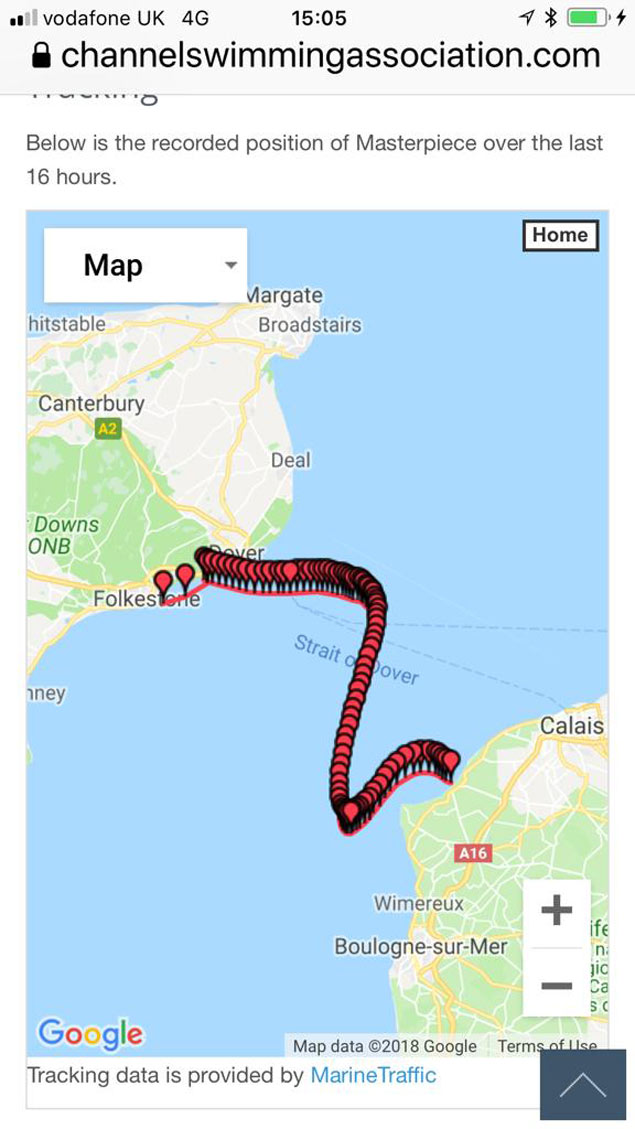 Kevin Procter's swim route
Kevin Procter's swim route
Kevin issued the following statement: "I have chosen this charity to make people aware of skin cancer, moles and other debilitating skin disorders. I myself had a very lucky escape with a dangerous melanoma mole on my shoulder. The nurse from the ward said in 30 years she had not had a success case like mine. Within as little as 6 weeks, it could have gone deep enough into my body to break off, and spread anywhere! I just got away with a small procedure, and a few weeks out the water not swimming!"
Kevin raised almost £1000 with his feat of endurance, preparing for the event with various other swimming races in the months leading up to the Channel swim. The money will go towards The British Skin Foundation, and be used to fund research into all types of skin disease, including the same type of cancer which could have very easily taken Kevin's life. It will go on to impact the lives of millions of people in coming months.
A keen athlete, Kevin is a member of Dursley Running Club and Swindon Triathlon Club and he trains regularly at Lake 32 at Waterland Outdoor Pursuits in the Cotswolds and Cromhall Quarry in Gloucester.
Skin disease can only be combated by a continued commitment to research, development and funding, and the money raised by Kevin will play a vital role in how The British Skin Foundation attempt to tackle skin disease next. For Kevin, he knows he had an incredibly lucky escape, and is just glad to have played his part in the fight against cancer with his impressive feat of endurance, grit and willpower.


























